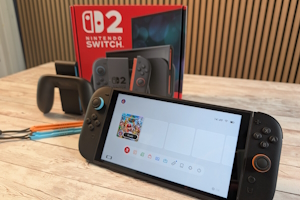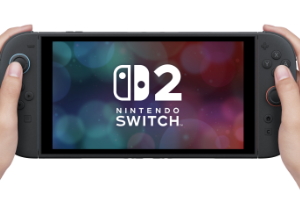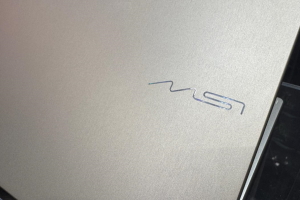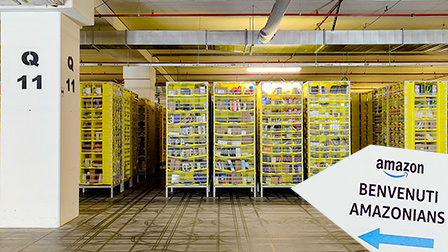Roundup lettori DVD su Digit-Life

Roundup lettori DVD su Digit-Life: analisi dei più recenti lettori DVD e non solo
di Alessandro Bordin pubblicata il 29 Novembre 2001, alle 10:39 nel canale StorageRiportiamo, in lingua inglese, direttamente dal sito, le conclusioni relative ai dispositivi:
12X
16XAOpen DVD-1240/AMH
This drive is a good budget solution. It excellently plays DVD-Video discs, finely reads standard CD-ROM discs. On its front panel there are buttons for playing Audio CDs. Unfortunately, the drive operates slowly with CD-R/RW discs, and implements capture of audio tracks with errors. Moreover, the AOpen drive makes quite a lot of noise even at a low speed of operation with CDs. Vibration is not eliminated completely. At last, the drive can get the RPC-1 support by changing its firmware version.
ASUS DVD-E612
This one is a good choice. It excellently reads both CDs and DVDs. Audio tracks are captured rather finely. On its front panel it has buttons for playing Audio CDs which can also be used for changing speed of operation with CDs. Unfortunately, the drive failed to finish reading data from the 780 MBytes CD-R. Thanks to a good speed reduction system in operation with CDs the drive doesn't produce much noise. The ASUS doesn't vibrate either. The device can be turned into the RPC-1 with the help of the jumper.
MSI MS-8212
This drive reads exceptionally well both CDs and DVDs. It copes with capture of audio tracks. Noise can be reduced to an acceptable level with the help of external programs. The vibration protection system works quite well. The drive, however, can be installed only in a horizontal position. From the very beginning this model has the RPC-1 support.
Hitachi GD-7500
On the one hand, the drive excellently copes with operations of audio track capture and can work with DVD-RAMs. On the other hand, it awfully reads low-quality discs. Its noise characteristics are not superb. It trembles noticeably even when working with usual discs. The drive can get the RPC-1 support by changing the firmware version or with a special utility.
NEC DV-5800A
This is an average drive. It copes quite well with playing DVD-Video discs and reads rather well standard CD-ROM and CD-R/RW discs. No problems appear also when the drive captures audio tracks. Unfortunately, it failed to finish reading of a 780 MBytes disc. Besides, it made quite a lot of noise even at a lower speed while working with CDs. However, noise can be reduced with exterior programs. The drive noticeably vibrates when it works with badly balanced discs, but reading is still successful. The drive can become a pseudo-RPC-1 by changing its firmware version.
PANASONIC SR-8586B
You should go with this drive if you are going to work only with DVD discs as it doesn't cope with CDs, especially low-quality ones. It doesn't excel in capturing audio tracks, that is why professionals should be careful. A noise level is not low, though it can be reduced with exterior programs. The drive noticeably vibrates when it works with badly balanced discs, but reading is still successful. The drive can become a RPC-1 by changing its firmware version.
SONY DDU1621
This is an attractive drive for a home user. It excellently reads all types of CDs and DVDs. No problems appear also when the drive captures audio tracks. A noise level is low, and the only negative impression is when the spindle starts. As this drive is shorter than usual ones it can be used in system blocks where normal drives do not fit. The drive noticeably vibrates when it works with badly balanced discs, but reading is still successful. It can become a RPC-1 by changing its firmware version.
TOSHIBA SD-M1612
It's not a bad drive. It excellently reads all types of CDs and DVDs. Besides, it is able to read DVD-RAM. No problems appear also when the drive captures audio tracks. Unfortunately, its noise level worsens the impression, but it can be reduced with exterior programs. The device noticeably vibrates when it works with badly balanced discs, but reading is still successful. The drive can't become a RPC-1.










 BOOX Note Air4 C è uno spettacolo: il tablet E Ink con Android per lettura e scrittura
BOOX Note Air4 C è uno spettacolo: il tablet E Ink con Android per lettura e scrittura Recensione Sony Xperia 1 VII: lo smartphone per gli appassionati di fotografia
Recensione Sony Xperia 1 VII: lo smartphone per gli appassionati di fotografia Attenti a Poco F7: può essere il best buy del 2025. Recensione
Attenti a Poco F7: può essere il best buy del 2025. Recensione Auto nuove? Per il 65% degli italiani sono troppo care, non dovrebbero costare oltre i 20.000 euro
Auto nuove? Per il 65% degli italiani sono troppo care, non dovrebbero costare oltre i 20.000 euro Droni solari Airbus volano nella stratosfera grazie alle nuove batterie al silicio: test riusciti a oltre 20 km di quota
Droni solari Airbus volano nella stratosfera grazie alle nuove batterie al silicio: test riusciti a oltre 20 km di quota Colpo da 15 milioni di dollari: chi ha rubato un carico di prodotti AMD e Apple?
Colpo da 15 milioni di dollari: chi ha rubato un carico di prodotti AMD e Apple? Elon Musk lancia l'allarme su GPT-5: 'OpenAI divorerà Microsoft'. Ma Nadella lo sfida con un sorriso
Elon Musk lancia l'allarme su GPT-5: 'OpenAI divorerà Microsoft'. Ma Nadella lo sfida con un sorriso iPhone 17 Pro sarà più costoso, ma anche più conveniente
iPhone 17 Pro sarà più costoso, ma anche più conveniente Leapmotor spinge sull'acceleratore: nuovo C10 AWD da 585 cavalli e ricarica ultraveloce a 800V
Leapmotor spinge sull'acceleratore: nuovo C10 AWD da 585 cavalli e ricarica ultraveloce a 800V Toyota vuole battere i produttori cinesi di auto elettriche. Come? Alleandosi con i loro fornitori
Toyota vuole battere i produttori cinesi di auto elettriche. Come? Alleandosi con i loro fornitori Colpo grosso di Musk: 14 ricercatori Meta hanno scelto xAI per il futuro dell'AI
Colpo grosso di Musk: 14 ricercatori Meta hanno scelto xAI per il futuro dell'AI Lip-Bu Tan a testa alta: il CEO di Intel non ha paura di Trump
Lip-Bu Tan a testa alta: il CEO di Intel non ha paura di Trump GPT5 disponibile per tutti e puoi già usarlo: offre Microsoft!
GPT5 disponibile per tutti e puoi già usarlo: offre Microsoft! Nasce l'alternativa a Worldcoin: Humanity Protocol lancia una rete da 1,1 miliardi di dollari per dare un'identità Web3 senza scanner dell'iride
Nasce l'alternativa a Worldcoin: Humanity Protocol lancia una rete da 1,1 miliardi di dollari per dare un'identità Web3 senza scanner dell'iride ASUSTOR presenta i nuovi NAS da rack Lockerstor R Pro Gen2 con CPU AMD Ryzen Pro
ASUSTOR presenta i nuovi NAS da rack Lockerstor R Pro Gen2 con CPU AMD Ryzen Pro iPhone 18, sensori Samsung realizzati in Texas: gli effetti dei dazi amari di Trump sui semiconduttori
iPhone 18, sensori Samsung realizzati in Texas: gli effetti dei dazi amari di Trump sui semiconduttori Xiaomi conquista il terzo posto nel mercato italiano: è l'unica in crescita nella Top5
Xiaomi conquista il terzo posto nel mercato italiano: è l'unica in crescita nella Top5




















6 Commenti
Gli autori dei commenti, e non la redazione, sono responsabili dei contenuti da loro inseriti - infoPenso completamente l'opposto per gli ASUS, dato che già i normali CD-S500-A (50x) leggono incredibilmente bene (*MEGLIO* dei masterizzatori) i CD-RW più incasinati (DirectCD heavly fragmented...) e hanno il controllo d'errore "C2" per le tracce audio.
I Panasonic (Matsushita) hanno una meccanica impeccabile e affidabile come da tradizione (al contrario dei Samsung... feccia!) mentre le prestazioni in base alle recensioni sulla rete sono medio-alte.
Gli LG, nelle versioni 12x (in stock originali dalla casa madre) hanno avuto alcune incertezze di *funzionamento* già da nuovi! Comunque a parte la casistica sembra che abbiano una meccanica di base molto curata (come Panasonic) e ottimizzata per la lettura sequenziale (lo dicono le recensioni su PC Pro o sulla rete). Io ho un modello LG 8x 40x e va una bomba (DVD rate da 4Mb/s a 10Mb/s con SmartRipper).
Sempre gli LG hanno la particolarità *unica* di avere una lettura costante anche durante le "accelerazioni" o le "decelerazioni" (un po' anche i Pioneer e i Panasonic), questo è molto importante nella copia diretta dei CD (almeno per chi non ha il B.P.) o durante la visione/ascolto di file multimediali.
Dalle versioni 12x in poi queste unità supportano il controllo d'errore C2 per l'estrazione digitale delle tracce audio e anche la qualità d'estrazione è priva di errori nei casi non difficili.
L'incapacità di "continuare a leggere" durante le accelerazioni/decelerazioni è l'unica nota stonata delle (ottime) unità ASUS, mancanza tra l'altro che accomuna tutti i lettori economici o di marche di scarso rilievo.
Per quanto riguarda i Nec una sola cosa, non girano mai alla velocità che promettono.
I Toshiba sono il pane dei clonisti (CloneCD) dato che skippano/distinguono/leggono i settori "danneggiati" senza problemi. Le prestazioni dei DVD 16x48x non sono esaltanti.
Caratt. tipiche:
ASUS: Riconoscimento e lettura di *qualsiasi* CD senza problemi
ed estrazione tracce audio ottima. Velocità programmabile da 4x in su a passi di 1x (tramite software DriveSpeed o simile). Prestazioni effettive sempre al massimo in let. sequenziale (50x) con i CD e CD-R. Il CD-S500 crea l'immagine su HD di un CD-R 80 pieno in meno di 2'00''.
PANASONIC: meccanica indistruttibile (molti posseggono dei let. CD 8x in buone condizioni mentre i let. CD 24x leggono i CD-RW senza intoppi), velocità di rotazione programmabile via software.
LG: Lettura sequenziale molto dinamica senza "trattenimento temporaneo" del canale IDE (basso anche l'utilizzo del processore).
Le unità CD 40x e oltre secondo una logica intelligente riescono automaticamente a stabilire qual'è la velocità utile in base alla frequenza con cui vengono letti/richiesti i dati dal CD (molto utile per es. durante la visione di un CD DivX che mediam. richiede solo 200kb/s), riducendo il rumore (sibilio) qual'ora non sia "giustificato". Caratt. che compensa il fatto che nessuna unità LG prevede di impostare manualmente la velocità di rotazione.
**nota** Anche se Nero o qualsiasi altro programma vi visualizza la possibilità di scegliere altre velocità (più basse) nella maggior parte dei casi l'unità NON PREVEDE questo per limitazioni di firmware/hardware.
Questa è una grossa mancanza, immaginate di consultare un'Enciclopedia su CD per un'ora con il lettore a tutto gas!!!
I lettori ASUS 50x prevedono addirittura di abbassare la velocità (a passi da 8x) tenendo premuto il tasto Play per alcuni secondi,
grande!!
se volessi prendermi il Toshiba allora per vedere i DVD non sarebbe questo granchè???
Meglio quindi il Panasonic???
Per vedere i DVD basta 1 o 2x.
Se si vuole andare sul sicuro per le caratteristiche complessive consiglio Panasonic o ASUS.
P.S.: gran parte dei lettori DVD marchiati Creative sono esattamente Panasonic.
Devi effettuare il login per poter commentare
Se non sei ancora registrato, puoi farlo attraverso questo form.
Se sei già registrato e loggato nel sito, puoi inserire il tuo commento.
Si tenga presente quanto letto nel regolamento, nel rispetto del "quieto vivere".